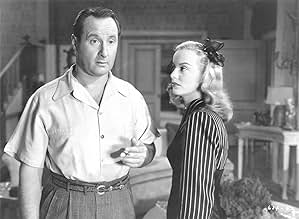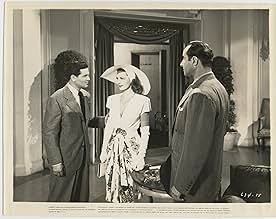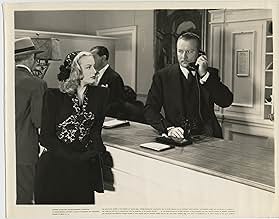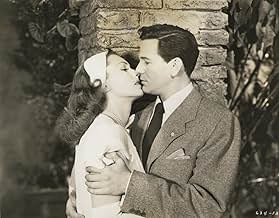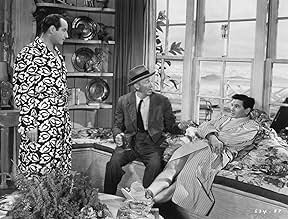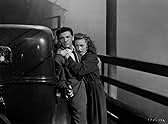NOTE IMDb
7,1/10
2,1 k
MA NOTE
Ajouter une intrigue dans votre langueEx-GI Nick Blake gets involved in a scheme to fleece a rich, young widow, but finds himself falling for her, much to the displeasure of his racketeer cohorts.Ex-GI Nick Blake gets involved in a scheme to fleece a rich, young widow, but finds himself falling for her, much to the displeasure of his racketeer cohorts.Ex-GI Nick Blake gets involved in a scheme to fleece a rich, young widow, but finds himself falling for her, much to the displeasure of his racketeer cohorts.
Richard Erdman
- Bellboy at The Marwood Arms
- (as Dick Erdman)
Fred Kelsey
- Railroad Conductor
- (scènes coupées)
Robert Arthur
- Bellhop
- (non crédité)
John Barton
- Barfly
- (non crédité)
Ted Billings
- Barfly
- (non crédité)
Jack Chefe
- Hotel Waiter
- (non crédité)
Adrian Droeshout
- Bar Patron
- (non crédité)
Commentaire à la une
Nobody Lives Forever (1946)
This is a quirky but good film. If technically a film noir in tone and structure, it largely lacks the darkness of intention in any of the main characters. Part of this comes from the casting—John Garfield is just too sweet a guy to pull off a devious, malicious scammer, and Walter Brennan as the sidekick couldn't appear evil if he tried.
There are some classic noir elements which make the movie fun, like a nightclub (and nightclub owner), a femme fatale (played with restraint by Faye Emerson), and a host of thugs who are convincing (this is Warner Bros. after all). The main plot is a kind of crime romance, where Garfield, an ex-con man playing a returning soldier, has half an intention to go straight but then gets roped into one last big scam. The victim is a rich young widow, and as Garfield goes after his mark he naturally falls in love. The people backing Garfield have a stake in his success and they don't like what's going on—he could just marry the widow and they'd be left in the cold.
So there is a turning of who is against who in the scenario. And this matters, but a lot of the first half of the movie is about the growing romance between the two leads. And it doesn't quite take off. I suppose it was important to make this widow a straight up type, a "good" woman," but casting Geraldine Fitzgerald made sure the chemistry would be restrained. You do want these two very nice people to make it, but it's not spiked with anxiety enough, or dreamy highs enough, to make you quite get swept away.
Where it gets interesting is when the thugs get in the way. The plot takes some terrific twists, and there are some some terrific atmospheric scenes at a pier in the second half of the movie, with large pumps running and the mist rolling by at night. People's better natures are revealed. A tragedy for one man becomes a lesson for our leading couple.
Director Jean Negulesco, though not as well known as a dozen of his contemporaries, made a series of strong, highly dramatic movies after the war that are often worth watching just for their moods. Here he uses legendary cinematographer Arthur Edeson ("Casablanca," "Frankenstein") to make this mood memorable and visually stunning. Throw in the usual high standards of Hollywood, and Warner Bros., at the time and you have a lot of why this movie, whatever its flaws, is still completely absorbing. Well worth watching.
This is a quirky but good film. If technically a film noir in tone and structure, it largely lacks the darkness of intention in any of the main characters. Part of this comes from the casting—John Garfield is just too sweet a guy to pull off a devious, malicious scammer, and Walter Brennan as the sidekick couldn't appear evil if he tried.
There are some classic noir elements which make the movie fun, like a nightclub (and nightclub owner), a femme fatale (played with restraint by Faye Emerson), and a host of thugs who are convincing (this is Warner Bros. after all). The main plot is a kind of crime romance, where Garfield, an ex-con man playing a returning soldier, has half an intention to go straight but then gets roped into one last big scam. The victim is a rich young widow, and as Garfield goes after his mark he naturally falls in love. The people backing Garfield have a stake in his success and they don't like what's going on—he could just marry the widow and they'd be left in the cold.
So there is a turning of who is against who in the scenario. And this matters, but a lot of the first half of the movie is about the growing romance between the two leads. And it doesn't quite take off. I suppose it was important to make this widow a straight up type, a "good" woman," but casting Geraldine Fitzgerald made sure the chemistry would be restrained. You do want these two very nice people to make it, but it's not spiked with anxiety enough, or dreamy highs enough, to make you quite get swept away.
Where it gets interesting is when the thugs get in the way. The plot takes some terrific twists, and there are some some terrific atmospheric scenes at a pier in the second half of the movie, with large pumps running and the mist rolling by at night. People's better natures are revealed. A tragedy for one man becomes a lesson for our leading couple.
Director Jean Negulesco, though not as well known as a dozen of his contemporaries, made a series of strong, highly dramatic movies after the war that are often worth watching just for their moods. Here he uses legendary cinematographer Arthur Edeson ("Casablanca," "Frankenstein") to make this mood memorable and visually stunning. Throw in the usual high standards of Hollywood, and Warner Bros., at the time and you have a lot of why this movie, whatever its flaws, is still completely absorbing. Well worth watching.
- secondtake
- 2 mai 2014
- Permalien
Histoire
Le saviez-vous
- AnecdotesWhen Nick leaves the hospital at the beginning, the patch on his uniform's left shoulder indicates he was a member of the U.S. Army's First Infantry Division, nicknamed "The Big Red One". Later in the film Nick mentions seeing destroyed churches in Italy. The 1st Inf. Division saw action in Sicily, as well as North Africa, the D-Day invasion at Omaha Beach, the Battle of the Bulge and through the heart of Germany, ending up in Czechoslovakia by the end of the war.
- GaffesAs Pop is proposing the con on the widow to Nick and Al, the same couple (a blonde and a man in a vertically striped robe) walks past the window along the beach from right to left twice.
- Citations
Nick Blake: People like me don't change.
- ConnexionsFeatured in Los Angeles Plays Itself (2003)
Meilleurs choix
Connectez-vous pour évaluer et suivre la liste de favoris afin de recevoir des recommandations personnalisées
- How long is Nobody Lives Forever?Alimenté par Alexa
Détails
- Date de sortie
- Pays d’origine
- Langue
- Aussi connu sous le nom de
- Niko ne zivi vecno
- Lieux de tournage
- Mission San Juan Capistrano - 26801 Ortega Highway, San Juan Capistrano, Californie, États-Unis(Nick and Gladys tour the mission)
- Société de production
- Voir plus de crédits d'entreprise sur IMDbPro
- Durée1 heure 40 minutes
- Couleur
- Rapport de forme
- 1.37 : 1
Contribuer à cette page
Suggérer une modification ou ajouter du contenu manquant

Lacune principale
By what name was Nobody Lives Forever (1946) officially released in India in English?
Répondre














